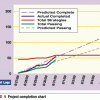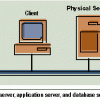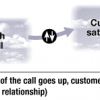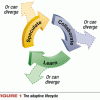|
|
Risky Beginnings: How to Start Software Projects Off on the Right Foot Esther Derby's opening comments set up the thrust of her enlightening article: "Have you ever managed a project that went directly, hopelessly, and irretrievably to hell? Would you like to avoid some of the traps so your project doesn’t end up there?"
|
|
|
|
The Quality Barometer A QA manager is often faced with measuring the impossible. Here is a simple, post-ship metric to help judge the test effort's effectiveness. The Quality Barometer method uses the bug counts found during testing, calculates a percentage, and then uses that percentage as the defect target number that can be tolerated after shipment.
|
|
|
|
Your Piece of the Pie More than 1,800 industry professionals responded to the third annual STQE/StickyMinds salary poll. The results suggest that, although it has been an unsettling year, the picture doesn't look all that bad for software QA professionals.
|
|
 |
Perspectives from a Test Manager: Four Keys to Keeping Your Testing on Track This article highlights four keys to getting better organized: 1. A common set of ground rules on the test progress, defect reporting, and verification; 2. The ability to convey how your team’s testing is going--on a frequent basis; 3. Knowing what needs to be tested--and being able to stand behind the reasons why; 4. Maintaining good communication with the development leaders to help move the product through the development phases--being proactive rather than reactive.
|
|
|
|
Lessons in Test Automation Elfriede Dustin has worked on many projects at various companies where automated testing tools were introduced to a test program lifecycle for the first time. In reviewing these projects, she has accumulated a list of "Automated Testing Lessons Learned," taken from actual experiences and test engineer feedback. In this article, she will share examples of this feedback, hoping that this information will help you avoid some typical false starts and roadblocks.
|
|
 |
Testing Web-based Applications To be most effective in analyzing and reproducing errors in a Web environment, you need to have a command over the operating environment. You also need to understand how environment-specific variables may affect your ability to replicate errors. With the application of some of the skills covered in this article, your Web testing experience should be less frustrating and more enjoyable.
|
|
 |
Designing Useful Metrics: Using Observation, Modeling, and Measurement to Make Decisions First-order measurement can help you understand what's going on, make decisions, and improve results. Observation, modeling, and simple data gathering are things that you can implement in your work group without a big measurement program or big funding. Start by modeling your system and working out on paper how different measures will affect your system. Then involve your team, expand your model, and try some simple data gathering. This approach to measurement is one more tool in your toolkit, and it will move your organization toward better quality.
|
|
|
|
The Influential Test Manager: How to Develop and Use Influence to Help Your Test Group - and Project - Succeed Test managers often feel that while somebody might be in control of schedules or resources, they certainly are not. An experienced test manager shares ways to develop and use professional influence to help the test group.
|
|
 |
Retiring Lifecycle Dinosaurs: Adaptive Software Development Adaptive Software Development (ASD) is one of a growing number of alternatives to traditional, process-centric software management methods. Extreme Programming (XP), Lean Development, SCRUM, and Crystal Light methods—although different in many respects—are tied together by a focus on people, results, minimal methods, and maximum collaboration. They are geared to the high speed and high change of today's e-business projects.
|
|
|
|
Risk-Based Testing: How to Conduct Heuristic Risk Analysis Software testing is often motivated by risk. If you accept this premise, you might well wonder how the term "risk-based testing" is not merely redundant. However, conducting a heuristic risk analysis by employing a checklist of open-ended questions, suggestions, or guidewords is a proven approach to help you find the most important risks for developing your testing plans.
|
|

